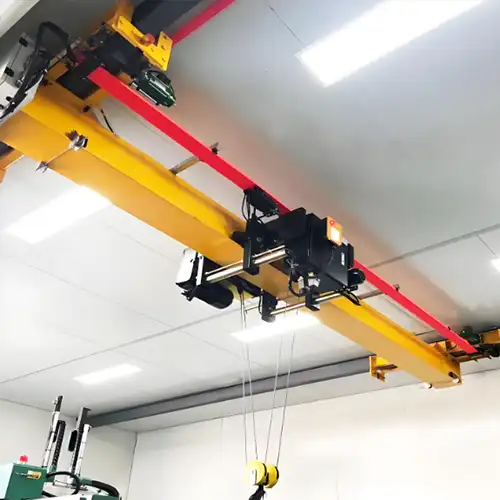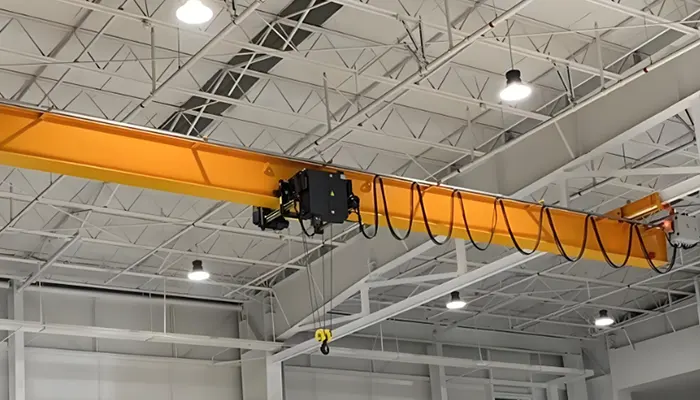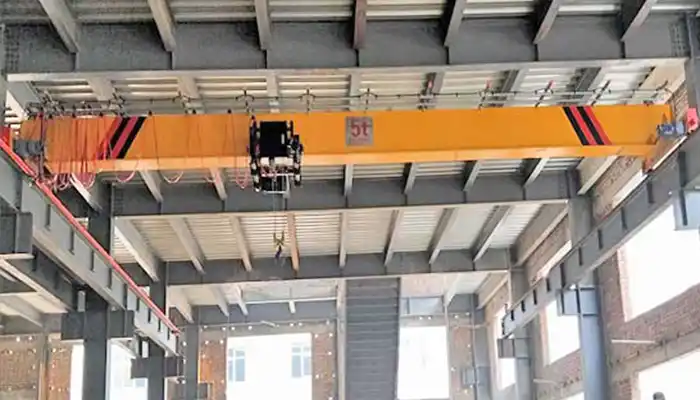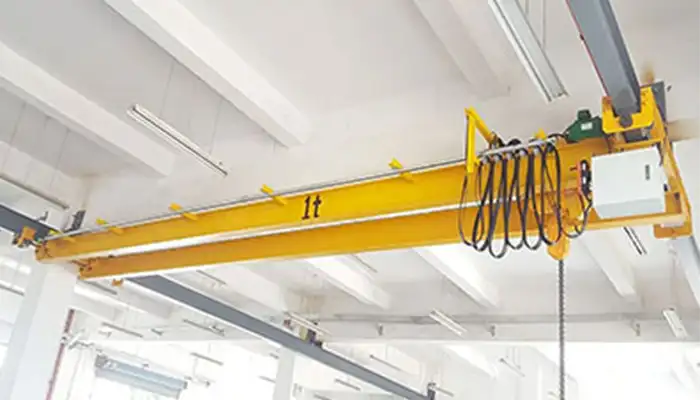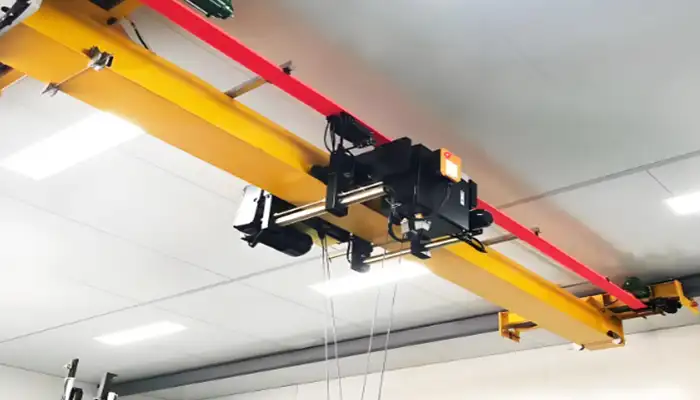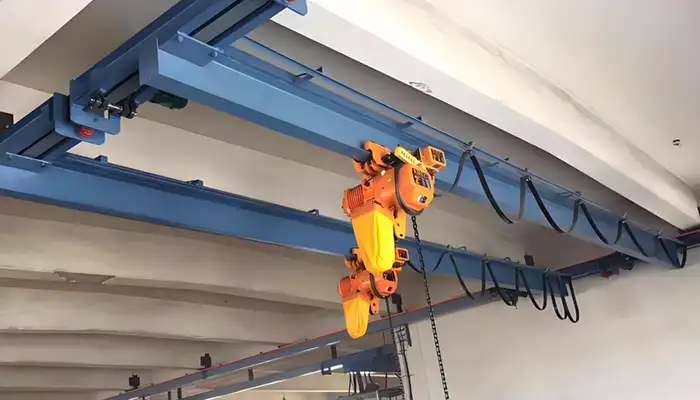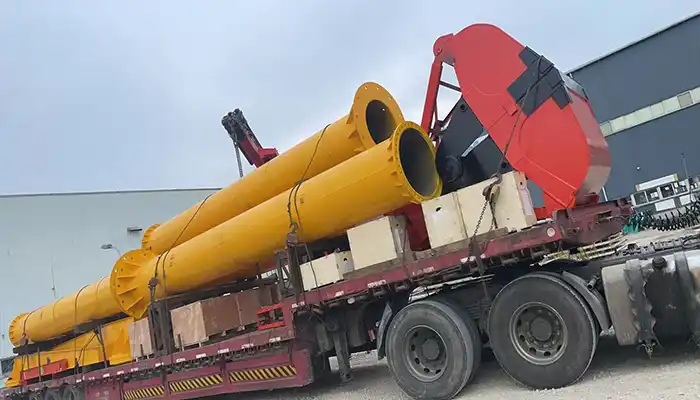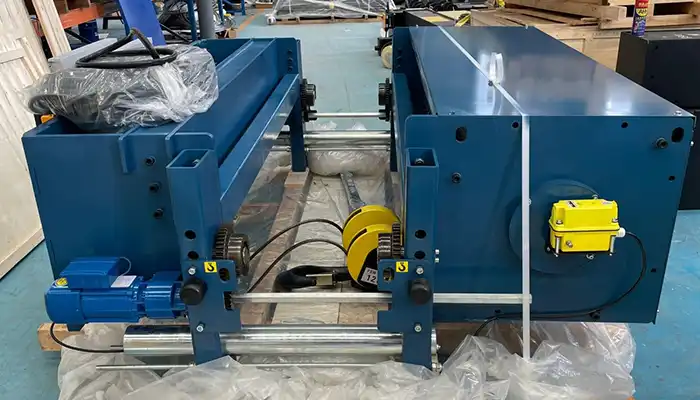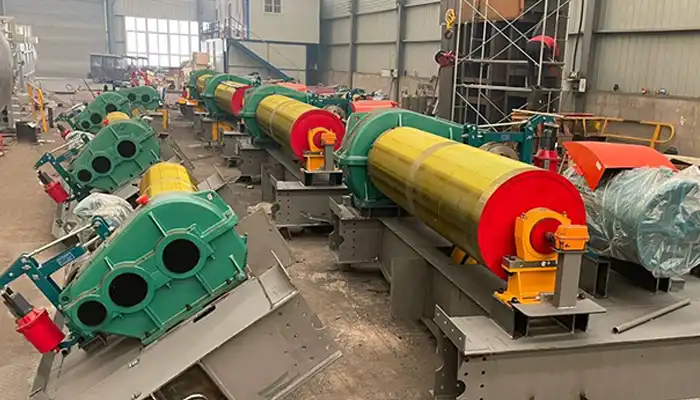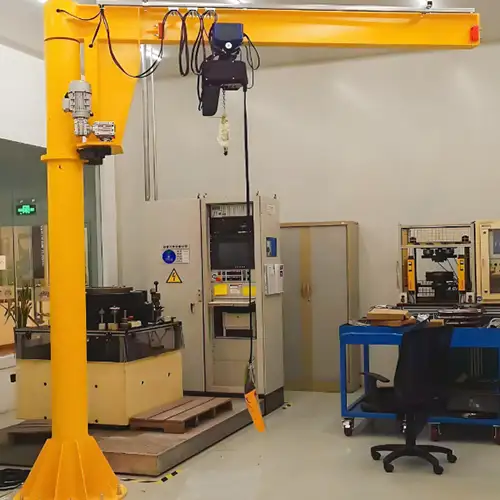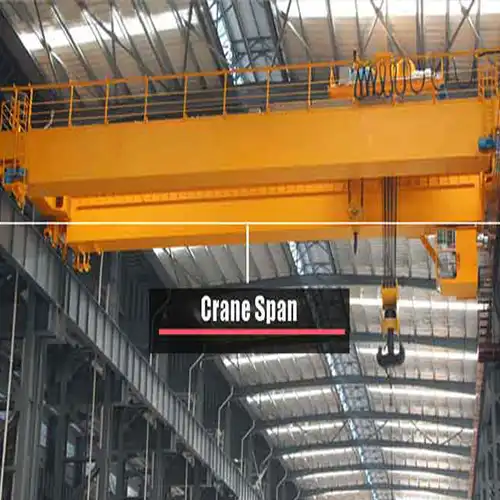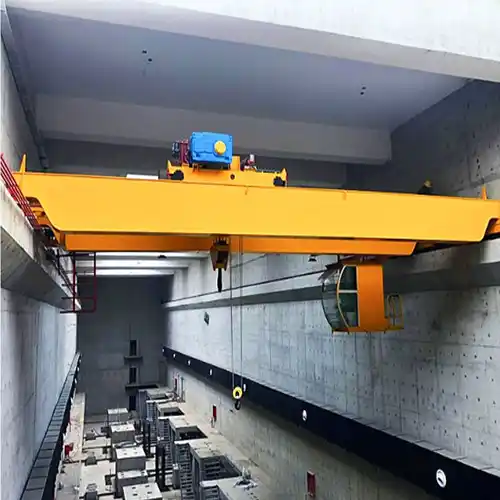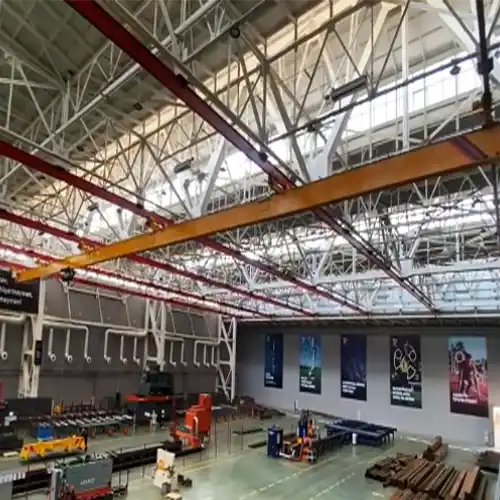Underhung Bridge Crane Cost: 1-10 Ton Underhung Crane Price Guide
How much does an underhung bridge crane cost? 1- 10 ton underhung bridge crane price guide for low-headroom workshops. Get underslung crane at good price!
Category: Underhung Bridge Crane
Your Trusted Underhung Bridge Crane Manufacturer & Supplier
Underhung Bridge Crane Cost: 1-10 Ton Underhung Bridge Crane Price Guide
A guide to understanding costs of 1-10 ton underhung cranes for low-headroom workshops, including design, installation, and maintenance.
What Is an Underhung Bridge Crane?
An underhung bridge crane is a type of overhead crane that hangs from the ceiling or building structure. Unlike top-running cranes, which run along tracks mounted above, underhung cranes are mounted below the rails. This makes them perfect for workshops with low ceilings or limited headroom.
- Maximizing Vertical Space: With an underhung crane, you get more usable space because it doesn't require high clearance.
- Heavy Lifting in Tight Spaces: Even in smaller workshops, these cranes can handle heavy loads efficiently, saving space while still getting the job done.
If your workshop has limited ceiling height, an underhung bridge crane is a smart choice. It lets you make the most of your space without sacrificing lifting capacity.
Why This Guide?
This guide is here to help you understand how much an underhung bridge crane costs and what factors affect the price. We'll explain everything you need to know so you can make an informed decision when choosing the right crane for your workshop.
- Clear Cost Breakdown: We'll give you a simple, step-by-step breakdown of what influences crane prices.
- Help with Decision-Making: Whether you're looking for a 1-ton crane or something larger, we'll help you figure out what's best for your needs.
By the end of this guide, you'll have a better idea of what to expect in terms of cost and features, making it easier to choose the crane that fits your workshop.
Who Is This Guide For?
This guide is for workshop owners, managers, and anyone involved in purchasing equipment for a workshop. If you're in charge of selecting a crane for a space with low headroom, this guide is made just for you.
- Workshop Owners & Managers: Whether you're handling light or heavy-duty tasks, you'll find useful information.
- Decision-Makers: If you're the one deciding what crane to buy, this guide will make sure you're equipped with the right knowledge to make the best choice.
If you're ready to invest in an underhung bridge crane, this guide will give you everything you need to make a smart, cost-effective choice.
Underhung Bridge Cranes
What Is an Underhung Bridge Crane?An underhung bridge crane is a type of overhead crane that hangs from the ceiling structure of a workshop. Instead of running on tracks mounted above, the crane moves along rails that are suspended below the ceiling.
How Does an Underhung Crane Differ from a Top-Running Crane?
Underhung cranes are different from top-running cranes in a few important ways. Here's a quick breakdown of the differences:
Track Position:
- Underhung cranes are mounted below the ceiling and run along tracks suspended from the beams.
- Top-running cranes run on tracks that are mounted above the workshop ceiling.
Space Usage:
- Underhung cranes are great for environments with limited ceiling height because they take up less vertical space.
- Top-running cranes require more vertical clearance, as the tracks and crane need more room above.
Installation:
- Underhung cranes are often quicker and easier to install, as they don't need as much structural modification to the building.
- Top-running cranes might require additional changes to the building structure for installation.
Why Choose Underhung Cranes for Low-Headroom Workshops?
Underhung cranes are especially suitable for workshops with low ceilings. Here's why they work so well in these environments:
- Maximizing Vertical Space: Underhung cranes don't take up space above the workshop. Since the crane hangs from the ceiling, there's more room for other equipment or storage below, making it ideal for tight spaces.
- Perfect for Low Ceilings: For workshops with limited headroom, underhung cranes can lift and move heavy loads without needing tall ceilings. They make the most of the available space, without the need for extra clearance.
- Space-Efficient: Since the crane is mounted under the rails, it doesn't require overhead tracks or additional height. This makes underhung cranes a practical solution in workshops where maximizing space is crucial.
In summary, if you're working in a space with limited ceiling height, an underhung bridge crane is the perfect solution. It allows you to get the lifting power you need while making the most of your workshop's available vertical space.
Key Factors Influencing the Cost of Underhung Bridge Cranes
When shopping for an underhung bridge crane, there are several factors that will impact the final price. These include the crane's capacity, span, lift height, design features, and more. Let's break down each factor to give you a better understanding of what affects the cost.
Capacity: Impact of Load Capacity (1 Ton to 10 Tons)
The load capacity is one of the most significant factors influencing crane pricing. The heavier the load a crane can lift, the more expensive it will be.
- Smaller Capacities (1 Ton to 3 Tons): Generally, smaller cranes are less expensive because they are designed for lighter loads and simpler operations.
- Medium Capacities (5 Tons to 10 Tons): As the capacity increases, the price does as well. Cranes with higher capacities require stronger components, larger hoists, and more robust design to handle the weight.
In simple terms, the bigger the load, the higher the cost. So, if your workshop requires cranes that can lift heavier loads, be prepared for higher upfront costs.
Span and Lift Height: How Span and Lift Height Affect Cost
The span is the distance between the crane's support beams, while lift height refers to how high the crane can lift its load. Both of these factors play a major role in determining the crane's overall cost.
- Span: A wider span requires more material and stronger structural support, which increases the cost.
- Lift Height: If you need a crane with a higher lift range, you'll pay more for the added lift mechanism and the stronger components required to reach greater heights.
In short, the more expansive the crane's reach (both horizontally and vertically), the more expensive it will be.
Design Features: Customization Options
Cranes are highly customizable, and the specific design features you choose can impact the cost.
- Hoists: The type of hoist (electric chain hoist, wire rope hoist, etc.) you choose will influence the price. More advanced hoists can add to the cost but offer better performance and reliability.
- Freestanding Columns: If your crane needs to be supported by freestanding columns (instead of the building structure), this will add to the price, as you'll need additional support structures.
- Special Configurations: Features like cantilever designs, explosion-proof options, or customized spans add complexity and cost to the crane design.
Customization offers flexibility but comes at a price. Think about what specific features your workshop needs, as each option could raise the overall cost.
Installation and Site Preparation: Costs for Installation
Installation costs are another key factor. These costs include setting up the crane, making any necessary structural changes to your building, and connecting the electrical system.
- Structural Support: If your building's structure needs reinforcement to support the crane, it could increase installation costs.
- Electrical Systems: Setting up the power supply, control systems, and safety mechanisms can add to the total cost.
- Labor: The complexity of the crane installation and the time required will influence how much labor costs.
Proper site preparation and installation are crucial for ensuring the crane operates safely and efficiently. Be sure to factor in these costs when budgeting.
Manufacturer and Certifications: Influence of Reputation and Certifications
The manufacturer's reputation and the crane's certifications can influence both the price and quality of the crane.
- Reputation of the Manufacturer: Well-known manufacturers with a track record of quality and reliability may charge more for their cranes. However, their products are likely to last longer and require less maintenance, making them a good investment in the long run.
- Certifications (e.g., CE, ISO): Cranes that are CE or ISO certified may cost more due to the rigorous testing and quality control processes they undergo. However, these certifications ensure that the crane meets certain safety and quality standards, which can justify the higher price.
When considering the manufacturer, balance the upfront cost with the expected long-term reliability and performance.
After-Sales Support and Maintenance: Ongoing Costs
The cost of ongoing support, maintenance, and spare parts should also be considered when evaluating the total cost of ownership for your crane.
- Maintenance: Regular maintenance is essential to ensure the crane runs smoothly and lasts longer. Some manufacturers offer maintenance packages, but they can add to the overall cost.
- Spare Parts: Replacement parts for the crane can be expensive, especially if the crane has specialized components or is a custom design.
- After-Sales Support: High-quality customer support and service contracts can add to the cost but can save you money in the long run by reducing downtime and ensuring the crane remains in good condition.
Make sure to inquire about after-sales services and maintenance packages when getting a quote, as these can impact the long-term cost of owning the crane.
In conclusion, understanding how these factors influence the cost of underhung bridge cranes can help you make a more informed decision. The more customized and complex the crane, the higher the price. Keep in mind that while you may pay more upfront for advanced features, the long-term benefits could make it worth the investment.
Price Breakdown for 1 Ton - 10 Ton Underhung Bridge Cranes
Understanding the price range for underhung bridge cranes is essential when choosing the right one for your workshop. Here's a detailed breakdown of the typical price ranges and factors that affect the cost for different load capacities.
1 Ton Underhung Cranes
Typical Price Range: The price for a 1-ton underhung crane typically ranges from $2,000 to $6,000, depending on the design and customization features.
Ideal Applications and Design Features: 1-ton cranes are ideal for small workshops or light-duty tasks, such as lifting small machines, tools, or parts. They are commonly used in:
- Automotive workshops
- Small manufacturing plants
- Light assembly lines
Design features often include:
- Electric chain hoists for smooth operation.
- Compact hoist designs for tighter spaces.
Cost Factors:
- Hoist type (electric vs. manual).
- Customization like adding specialized controls or safety features.
- Installation complexity (basic setups vs. needing structural support).
2 Ton Underhung Cranes
Price Range and Typical Applications: The price range for 2-ton cranes typically falls between $3,000 and $8,000. This is a popular choice for small to medium-duty tasks.
Cost Considerations for Small to Medium-Duty Tasks: These cranes are best for lifting heavier items than a 1-ton crane but still in light to medium workloads. Common uses include:
- Metalworking shops
- Light industrial applications
- Warehouse operations
They often come with:
- Higher-quality hoists for more frequent use.
- Adjustable spans for added flexibility.
Factors That Influence Price:
- Span and lift height: A wider span or taller lift height will increase the price.
- Motor and control features: Variable speed motors and additional safety features can add to the cost.
- Freestanding columns if needed.
3 Ton Underhung Cranes
Pricing Overview and Popular Features: A 3-ton underhung crane typically costs between $4,500 and $10,000, depending on the specific features and configurations.
Applications in Small Workshops with Tight Headroom: These cranes are perfect for workshops with tight spaces and lower headroom, where you need slightly more lifting capacity but still need to keep the design compact. They are often used in:
- Machine shops
- Woodworking and carpentry workshops
- Small assembly lines
Popular features may include:
- Electric hoists with higher lift speeds.
- Enhanced safety systems (e.g., overload protection).
Price Influencers:
- Customization options, including specialized hoists or hoist positions.
- Span adjustments that cater to different workshop layouts.
5 Ton Underhung Cranes
Pricing Range: Expect to pay between $6,000 and $15,000 for a 5-ton underhung crane, depending on the design and features you select.
Common Use Cases and Customization Options: The 5-ton crane is commonly used in medium-duty applications where heavier lifting is required. Some common use cases include:
- Construction sites
- Heavy manufacturing plants
- Industrial maintenance workshops
Customization may include:
- Upgraded hoists for better load control.
- Remote control options for ease of operation.
Factors That Impact Price:
- Customization (e.g., motorized trolleys, custom spans).
- Specialty features like explosion-proof designs or higher lift heights.
10 Ton Underhung Cranes
Price Range for Higher Capacity Cranes: A 10-ton underhung crane can range from $12,000 to $25,000 or more, depending on the complexity and features.
Specialized Design Features for Handling Heavier Loads: These cranes are built to handle much heavier loads and typically include:
- Stronger hoists and motors capable of handling large, heavy equipment.
- Advanced control systems for smooth lifting operations.
- Reinforced structural components for added durability.
Suitable Environments and Industries: 10-ton cranes are typically used in industries that require heavy-duty lifting and have enough space for larger crane setups, including:
- Steel mills and factories
- Construction and demolition sites
- Heavy equipment repair shops
These cranes often come with additional features like:
- Explosion-proof options for hazardous environments.
- Remote control systems for safer operation in busy workspaces.
Cost Considerations:
- Structural reinforcement if the building needs additional support for heavier cranes.
- Advanced safety features like anti-collision systems.
Here's the price breakdown for 1-ton to 10-ton underhung bridge cranes in a table format:
| Crane Capacity | Price Range | Ideal Applications | Common Features | Cost Factors |
|---|---|---|---|---|
| 1 Ton | $2,000 - $6,000 | Small workshops, light-duty tasks, automotive or tool handling | Electric chain hoists, compact design | Hoist type, installation complexity, customization options |
| 2 Ton | $3,000 - $8,000 | Small to medium-duty tasks, light industrial and warehouse operations | Higher-quality hoists, adjustable spans | Span & lift height, motor & control features, freestanding columns |
| 3 Ton | $4,500 - $10,000 | Small workshops with tight headroom, machine shops, assembly lines | Electric hoists, overload protection, enhanced safety systems | Custom hoists, span adjustments, safety features |
| 5 Ton | $6,000 - $15,000 | Medium-duty applications, manufacturing, industrial maintenance | Upgraded hoists, remote control options | Customization (motorized trolleys, custom spans), specialty features |
| 10 Ton | $12,000 - $25,000 | Heavy-duty environments, steel mills, construction, heavy equipment repair | Stronger hoists, advanced control systems, explosion-proof options | Structural reinforcement, advanced safety features, motor type |
This table summarizes the pricing range, applications, common features, and key cost factors for different capacities of underhung bridge cranes, helping you understand what to expect at each level.
Crane Design Considerations and Their Impact on Cost
The design of an underhung bridge crane plays a key role in its cost. Various design options—such as single girder vs. double girder, cantilever designs, hoist types, freestanding columns, and explosion-proof features—can all influence the final price. Understanding these options will help you make a more informed decision based on your needs and budget.
Single Girder vs. Double Girder
When choosing between a single or double girder crane, it's important to consider the application, load capacity, and operational frequency. Single girder cranes are typically more cost-effective and are ideal for light-duty applications, while double girder cranes are better suited for heavy-duty, high-frequency tasks that require higher lifting capacities and spans.

Single girder underhung bridge crane
Single Girder Design:
- Cost-Effective for Light-Duty Applications: Single girder cranes are simpler in design, with fewer parts and lower material costs. They are best for smaller workshops with lower capacity needs (usually up to 10 tons).
- Lower Installation and Maintenance Costs: Due to their simpler structure, single girder cranes are easier and cheaper to install and maintain.
Double Girder Design:
- Suitability for Heavy-Duty, High-Frequency Applications: Double girder cranes are designed for demanding tasks that require greater lifting capacity (typically above 10 tons), wider spans, and more frequent use.
- Higher Installation and Maintenance Costs: The added complexity and strength of the double girder design result in higher material, installation, and maintenance costs.
Price Differences:
- Single Girder Cranes: More affordable, with lower upfront costs. Ideal for light-duty tasks but not suited for high-demand environments.
- Double Girder Cranes: More expensive due to the added strength and higher lifting capacity, making them a better choice for heavy-duty and high-frequency operations.
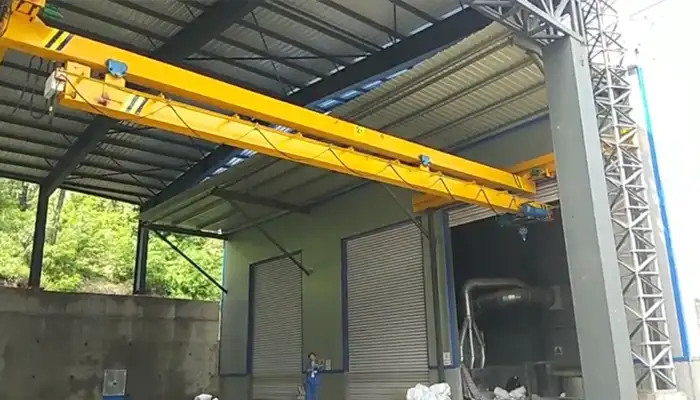
Cantilever Design
Underhung Bridge Crane with Telescoping Cantilever extend one end of the bridge beyond the support structure, making them a great solution for workshops with limited space or for when extended reach is required. This design is often used when the crane needs to handle loads outside the main support area.
- Explanation of Cantilever Cranes: A cantilever crane allows for extended reach without requiring additional support from the building. This is ideal for environments with narrow or limited floor space.
- Use in Extended Reach or Limited Floor Space: The cantilever design allows you to reach areas that would otherwise be difficult to access, making it especially useful for workshops where space is a premium or for those requiring a greater working radius.
- Price Impact: Adding a cantilever design to your crane will increase the price due to the additional structural reinforcement required. The length of the cantilever and its capacity will directly impact the final cost of the crane.
Hoists
The type of hoist you select for your underhung crane is another critical factor that affects the price. Different hoist types, such as electric chain hoists or wire rope hoists, have different load capacities, durability, and operational features, influencing the overall crane cost.
Types of Hoists:
- Electric Chain Hoists: These are more affordable and commonly used for lighter loads (up to 5 tons). They are reliable, easy to operate, and suitable for less demanding applications.
- Wire Rope Hoists: These are used for heavier loads (5 tons and above) and provide greater durability, lifting height, and load control. They are ideal for more demanding, heavy-duty operations.
How Hoist Type Affects Cost: Wire rope hoists are more expensive than electric chain hoists due to their higher lifting capacity, better durability, and ability to handle more rigorous tasks. Choosing the right hoist for your needs can significantly impact the overall price of the crane.
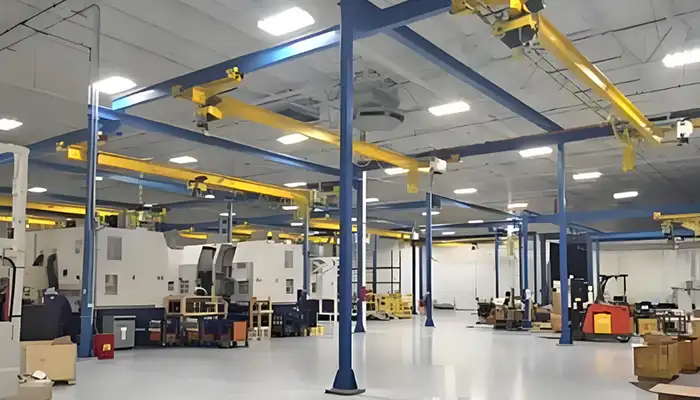
Freestanding Columns
Freestanding bridge crane with freestanding columns are sometimes necessary when the crane must be supported independently from the building structure. This design is required in cases where the ceiling or structure cannot bear the crane's weight or stress.
- When Freestanding Columns Are Necessary: In workshops where ceiling support is insufficient or when independent support is required, freestanding columns provide the stability necessary to safely operate the crane.
- Additional Costs for Freestanding Columns: Adding freestanding columns increases the cost due to the need for additional materials and labor. These columns require precise engineering and installation to ensure the crane remains stable and safe during operations.
Explosion-Proof Design
For hazardous environments, explosion-proof cranes are designed to prevent any sparks or heat that could ignite flammable materials or gases. These cranes are essential in industries like chemical processing, oil and gas, or pharmaceuticals, where safety is a top concern.
Explanation of Explosion-Proof Cranes: Underhung Bridge Crane wtih explosion-proof design are built with sealed components and special safety systems to ensure safe operation in environments where explosive substances may be present. They are crucial for preventing accidents in high-risk workplaces.
When Explosion-Proof Cranes Are Required: These cranes are needed in environments where the presence of volatile materials, such as chemicals, gases, or powders, creates a risk of fire or explosion. They are most commonly used in:
- Chemical processing plants
- Oil refineries
- Pharmaceutical manufacturing
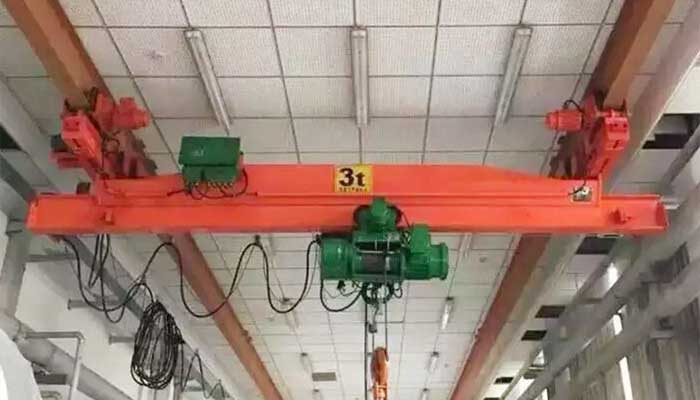
Additional Costs for Explosion-Proof Certification and Features:
Explosion-proof cranes are significantly more expensive than standard cranes due to the specialized components, certifications, and safety features required. The cost can increase by 10% to 30% depending on the environment and the level of certification needed for the specific industry.
In conclusion, the design features you select for your underhung bridge crane play a crucial role in determining its cost. Whether it's the choice between single girder vs. double girder, adding a cantilever design, selecting a hoist, or opting for explosion-proof features, each decision impacts the overall price. By understanding the benefits and costs associated with each design option, you can select the crane that best suits your operational needs and budget.
Here's the table simplified for easier reading and understanding:
| Design Feature | What It Means | How It Affects Cost |
|---|---|---|
| Single Girder vs. Double Girder | Single Girder: Best for light-duty tasks, simple design, and lower cost. Double Girder: Better for heavy-duty, high-frequency tasks with larger lifting capacity. | Single Girder: Cheaper to buy, install, and maintain. Double Girder: More expensive due to stronger materials and greater capacity. |
| Cantilever Design | A design where part of the crane extends beyond the support, allowing for extra reach or use in tight spaces. | Costs more because it requires extra support and structure for the extended reach. |
| Hoists | Electric Chain Hoists: Lower cost, suitable for lighter loads (up to 5 tons). Wire Rope Hoists: Higher cost, used for heavier loads (5 tons+), with more lifting power. | Electric Chain Hoists: Less expensive and easier to maintain. Wire Rope Hoists: More expensive but needed for heavier tasks. |
| Freestanding Columns | Columns that support the crane independently of the building structure, necessary if ceiling support is lacking. | Adds extra cost for materials and installation. |
| Explosion-Proof Design | Cranes built for hazardous environments (like chemical plants), preventing sparks or heat that could cause explosions. | Increases cost significantly (10%-30%) due to special safety features and certifications. |
This table highlights the design options and their cost implications in a simple and easy-to-understand format.
Additional Costs to Consider
When budgeting for an underhung bridge crane, it's important to account for more than just the base price. There are several additional costs that can affect the total investment. Here's a breakdown of key factors that should be considered.
Shipping Costs
Shipping costs vary based on the size, weight, and delivery distance of the crane. These costs are often overlooked but can be substantial, especially for larger or heavier cranes.
What Affects Shipping Costs:
- Size and Weight: The larger and heavier the crane, the higher the shipping costs. Cranes with more parts or longer spans require more space during transportation.
- Distance: Shipping from the manufacturer to the installation site plays a big role in determining the price. Long-distance shipments usually come with higher fees due to fuel costs, insurance, and handling.
Tips:
- Get a detailed shipping estimate before finalizing the crane purchase.
- Consider whether local suppliers can reduce shipping costs.
Customization Fees
Crane customization can greatly increase the cost depending on your workshop's specific needs. Custom features can include changes in span, hoist types, lifting capacity, or even crane speed.
Types of Customization:
- Custom Spans: If your space requires a crane with a specific span or custom bridge length, it will add to the cost.
- Hoist Modifications: Upgrading to a more powerful hoist (e.g., switching from an electric chain hoist to a wire rope hoist) or adding specific safety features can increase the price.
- Design Alterations: Unique designs, like cantilever extensions or customized bridge sizes, require additional engineering and materials.
Impact on Cost:
- Customization can add anywhere from 10% to 30% (or more) to the base price, depending on the level of modification.
Operational Costs
After the crane is installed, there are ongoing costs to keep it running efficiently. These include energy consumption, regular maintenance, and repairs.
Energy Consumption: Cranes with higher lifting capacities or complex hoist systems may consume more energy, increasing your electricity costs. Consider the crane's efficiency and the load cycle when estimating energy costs.
Maintenance Costs: Over time, parts will need replacing, and the crane will need servicing to ensure smooth operation. Budget for regular maintenance, including lubrication, parts inspections, and wear-and-tear repairs.
Long-Term Operational Costs:
- If your crane operates at high frequencies or heavy loads, maintenance costs can be higher.
- Always factor in the potential need for spare parts and unexpected repairs.
Installation Costs
Installing a crane isn't as simple as just placing it in position. It requires careful planning, site preparation, and potentially structural modifications to support the crane.
Site Preparation: Before installation, your workshop may need to be modified to accommodate the crane. This could involve reinforcing the ceiling, installing freestanding columns, or making other structural adjustments. The complexity of these changes can add significant costs to the installation.
Installation Fees: Beyond just placing the crane, you may need professionals to handle the assembly, wiring, and testing. Installation costs can vary based on the crane's size, design complexity, and the experience of the installation team.
Tips:
- Get a clear estimate for installation from the supplier.
- Account for any necessary structural work or permits required for installation.
| Additional Cost | Explanation | Impact on Cost |
|---|---|---|
| Shipping Costs | Shipping costs depend on the size, weight, and distance of the crane's transport. Larger and heavier cranes, as well as longer shipping distances, increase shipping costs. | Size & Weight: Larger and heavier cranes cost more to ship. Distance: Longer distances increase shipping fees. |
| Customization Fees | Customizations, like unique spans, hoists, or crane speed adjustments, can add to the cost. | Can add 10% to 30% (or more) to the base price depending on the level of customization. |
| Operational Costs | Energy usage, maintenance, and repairs over time. Includes energy consumption, regular servicing, and wear-and-tear. | Energy Consumption: Higher lifting capacity cranes consume more energy. Maintenance: Regular upkeep costs, including parts replacements and repairs. |
| Installation Costs | Costs associated with preparing the site and installing the crane. May require structural changes or specialized installation services. | Site Preparation: Modifications to the structure increase costs. Installation Fees: Professional assembly, wiring, and testing can add to the price. |
This table breaks down the key additional costs involved in purchasing and maintaining an underhung bridge crane, helping you prepare for the total investment.
All of these additional costs should be included in your overall budget when purchasing an underhung bridge crane. Shipping, customization, operational, and installation costs can quickly add up, so it's crucial to plan ahead. Taking these factors into account will ensure that you're fully prepared for the total investment involved in setting up and maintaining your crane system.
How to Get the Best Value for Your Money
When purchasing an underhung bridge crane, getting the best value for your money is about more than just negotiating the initial price. It involves considering long-term costs, quality, and support, ensuring you make a wise investment for your workshop. Here are some tips to help you get the most out of your purchase.
Negotiating Prices with Suppliers
Negotiating with suppliers can help you secure a better deal, but it requires knowing what to focus on and understanding the factors that influence the price.
Tips for Negotiation:
- Feature Adjustments: If certain features (like hoists or lifting capacity) are non-essential for your needs, see if you can reduce costs by opting for simpler options.
- Quantity Discounts: If you're buying multiple cranes or considering future orders, ask for bulk discounts or long-term pricing agreements.
- After-Sales Support: Don't forget to include the cost of after-sales support, maintenance packages, and warranties in your negotiations. Suppliers may offer deals on these services to sweeten the overall deal.
Be Clear About Your Needs: The more specific you are about your crane requirements, the easier it is for suppliers to provide a reasonable and fair price.
Consider Total Cost of Ownership
While the upfront cost of the crane is important, it's equally essential to consider the long-term expenses associated with operating and maintaining the crane.
What to Consider:
- Maintenance Costs: Regular upkeep is necessary to ensure the crane operates smoothly. Consider how often you'll need to replace parts, lubricate the system, and perform inspections.
- Energy Costs: Cranes consume electricity, and larger or more complex systems may have higher energy consumption. Factor this into your ongoing costs.
- Spare Parts: Over the years, you'll need to replace worn-out components. Choose a crane with easily accessible parts and a supplier who offers reasonable prices for spares.
Long-Term Value: By calculating these long-term costs, you can better understand the total cost of ownership. A slightly more expensive crane with lower operational costs may ultimately be a better investment.
Prioritizing Quality Over Price
In the world of industrial equipment, choosing quality over the lowest price can save you money in the long run. While it might be tempting to go for the cheapest option, opting for a reputable supplier and high-quality crane will provide greater reliability and lower maintenance costs.
Why Quality Matters:
- Reliability: A high-quality crane is less likely to break down or require expensive repairs, which can save you from unexpected downtime.
- Longevity: Cranes made with better materials and superior craftsmanship tend to last longer, meaning fewer replacements and a longer service life.
- Reduced Maintenance Costs: Quality equipment often requires less frequent servicing, which reduces ongoing maintenance costs.
Choosing a Reputable Supplier: Ensure the supplier is well-known for producing reliable cranes with good customer feedback. A reputable supplier will stand behind their products and offer solid after-sales support.
To get the best value for your money, consider negotiating with suppliers, understanding the total cost of ownership, and prioritizing quality over price. By focusing on these factors, you'll be better equipped to make a smart investment in your underhung bridge crane that will serve your workshop for many years.
Underhung Bridge Crane Kits Without a Main Girder: Economical Solutions for Low-Headroom Workshops
Underhung bridge cranes without a main girder, sometimes referred to as kit cranes or kit-based systems, offer a cost-effective solution for low-headroom workshops. These systems generally rely on simpler designs that reduce the overall cost while still delivering the necessary lifting capacity.
What Is an Underhung Bridge Crane Kit Without a Main Girder?
Design Overview:
Unlike traditional underhung bridge cranes that include a main girder, these systems are designed with a simplified structure that may omit the main girder or reduce its size.
The lifting mechanism (hoist and trolley) is typically supported by smaller structural elements like beams or freestanding columns, relying on the existing infrastructure of the building or other crane components for support.
Key Components of the Kit:
- Hoists: Electric chain or wire rope hoists are still central to the system, providing the lifting functionality.
- Trolley and Track: The crane moves along a track system, but the overhead girder may be minimal or absent. The trolley is often supported by the building's existing ceiling or other structural supports.
- Freestanding Columns: In some cases, columns are used to support the crane system without the need for a full main girder. These are often used in modular, lightweight setups.
Benefits of Underhung Bridge Crane Kits Without a Main Girder
Cost-Effective Solution:
The elimination or reduction of a main girder significantly lowers manufacturing and material costs. This makes it one of the most economical crane systems available, especially for light-duty applications.
- Affordable for Smaller Workshops: Ideal for smaller operations with lower lifting needs (1-3 tons) that don't require heavy-duty cranes.
Space-Efficient:
By utilizing the building's existing structure or incorporating freestanding columns, these systems save valuable overhead space in low-headroom environments.
- Maximizes Vertical Space: The compact design allows for better use of available vertical space, crucial in workshops with low ceilings.
Simpler Installation and Maintenance:
These crane kits are easier and faster to install, as they often require less modification to the workshop's structure.
- Maintenance costs tend to be lower, as the system has fewer components and a simpler design compared to traditional underhung cranes.
Applications of Underhung Bridge Crane Kits Without a Main Girder
- Light-Duty Operations: Perfect for workshops handling smaller loads (1 ton to 3 tons) or lower-frequency tasks where minimal lifting capacity is required.
- Small Manufacturing Facilities: Ideal for environments where space constraints and cost-efficiency are top priorities, such as small factories, repair shops, or warehouses.
- Modular Systems for Growing Workshops: These cranes can be adapted to suit the specific needs of growing businesses. They are often scalable and can be expanded with additional components as the workshop's requirements evolve.
When to Choose a Crane Kit Without a Main Girder
- Budget Constraints: If your budget is tight and the lifting needs are minimal, opting for a kit without a main girder offers a practical and affordable solution.
- Limited Ceiling Height: For workshops with low ceilings, the crane's design can be customized to fit within the available headroom without compromising functionality.
- Low-Frequency Lifting: These cranes are ideal for operations with fewer lifting requirements or where the crane is not in constant use.
Price Range for Underhung Bridge Crane Kits Without a Main Girder
Typical Price Range: These systems are generally more affordable than full underhung cranes with main girders. Prices for small kits (1 ton to 3 tons) can start from as low as $3,000 to $5,000, depending on customization and additional features.
Cost-Saving Features:
Reduced structural components (no main girder) mean lower material costs.
Simpler installation reduces labor and setup costs.
Considerations Before Purchasing
- Limited Lifting Capacity: These kits are best suited for light-duty applications, so workshops requiring higher lifting capacities or frequent usage may find them inadequate.
- Customization Options: While they offer economic benefits, these kits may have limited customization options compared to full underhung bridge cranes. Ensure the system meets your specific needs before purchase.
Conclusion: Is an Underhung Crane Kit Without a Main Girder Right for Your Workshop?
- Ideal for Small, Low-Cost Operations: These kits are a practical solution for workshops with limited budgets or light-duty lifting needs.
- Space-Saving and Economical: The kit-based system provides an economical way to get the benefits of an underhung bridge crane without the higher costs of more complex systems.
- Best for Low-Headroom and Less Frequent Use: If your workshop has limited headroom and doesn't require heavy lifting, a kit without a main girder offers significant savings while still meeting basic operational needs.
This expanded section on underhung bridge crane kits without a main girder provides an economical and practical solution for low-headroom workshops, giving readers a deeper understanding of the cost-saving benefits of these simplified systems.
Conclusion
When investing in an underhung bridge crane for your workshop, it's essential to consider various factors that impact both the initial cost and long-term value. From crane design to installation costs, each decision you make will affect your total investment.
Summary of Key Considerations
To recap, here are the main factors that will influence the price of an underhung bridge crane:
- Crane Capacity and Design: Whether you choose a single girder or double girder crane, and the crane's lifting capacity, will significantly impact the cost.
- Customization: Special features like cantilever designs, hoists, and explosion-proof configurations will add to the price.
- Operational and Maintenance Costs: Long-term costs such as energy usage, regular maintenance, and spare parts must be factored into your overall budget.
- Shipping, Installation, and Support: Don't forget to account for the costs of shipping, site preparation, and installation, along with after-sales support and service.
Final Recommendations
Before purchasing an underhung bridge crane, take the time to evaluate your specific needs carefully:
- Assess Your Workshop Requirements: Understand the capacity and design that best fit your available space and tasks. If you have limited ceiling height, underhung cranes can provide significant benefits.
- Consider Long-Term Costs: Factor in the total cost of ownership, including maintenance, energy consumption, and potential future repairs.
- Choose Quality: Prioritize reliability and quality over price to ensure your crane lasts longer and reduces unexpected costs in the future.
Contact us Now!
- Reach Out for Customized Quotes: Contact multiple suppliers to get personalized quotes based on your workshop's specific needs. Don't hesitate to ask for detailed cost breakdowns.
- Consult with Experts: Consider consulting with the underhung bridge crane specialists who can help you identify the best crane type and design for your business. Their expertise will ensure you make a well-informed decision.
By carefully considering these factors, you'll ensure that you get the best value for your investment in an underhung bridge crane, enhancing both your operational efficiency and long-term cost savings.
Main Projects
Related Products
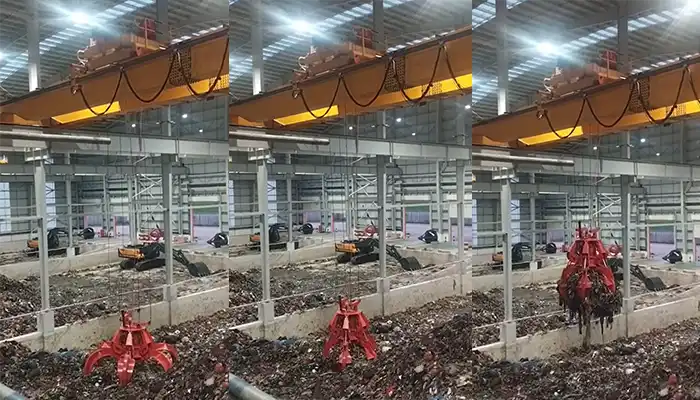
Supplied three grab bucket crane kits to Indonesia, enhancing garbage handling efficiency with high load capacity and reliable performance.
Free consultation to Confirm Parameters & Specifications and Get
Latest Crane Price & Crane Rate.
- Types of overhead cranes : _______?
- Optional: Overhead travelling crane, goliath gantry crane,Slewing jib crane, Single girder or double girder crane,small portable crane or kbk crane, etc.
- Capacity of overhead crane: _______?
- Optional: 0.25ton, 0.5 ton, 1 ton, 2 ton, 3ton, 5 ton, 10 ton,15ton, 20ton, 25 ton, 30ton,35ton, up to 550ton, etc.
- Crane span & lifting height : _______?
- Crane travelling length : _____?
- Control of overhead crane:_______?
- Optional: pendant/ remote/cabin control
- Voltage supply of overhead crane:_____?
- Eg,: 380V50/60HZ,3Phase or others,etc.
- Application/usage of crane:_______?
- Eg,: Steel mill, ,injection mold, cement,stone, concrete,granite, general manufacturing, etc.
Just leave a message via the contact form and our hoist and crane engineer will contact you with in 24working hours.
Get In Touch
